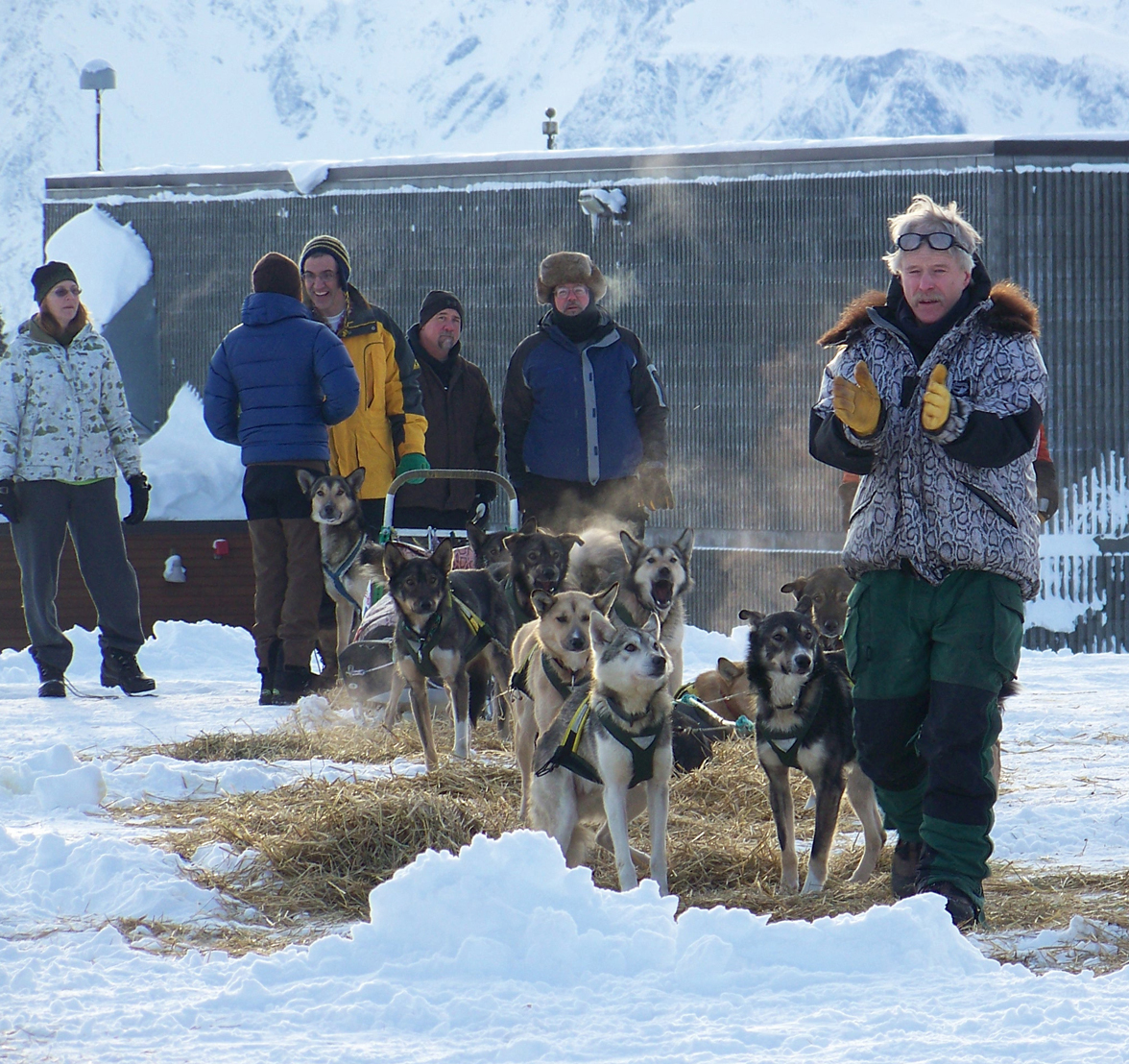Temperatures in Homer were hovering around zero degrees Sunday afternoon, but at the Tustumena 200 volunteers’ meeting at Captain’s Coffee enthusiasm for this weekend’s sled dog race was anything but chilly.
In 2012, the 200-mile race incorporated McNeil Canyon Elementary School as a checkpoint. Southern peninsula spectators took advantage of the accessible location to be on hand as 16 teams arrived on their way from the Kasilof starting line to the halfway mark, and a second time as they made their back to the Kasilof finish line.
At Sunday’s meeting, volunteers listened and asked questions as Tami Murray, race director and president, described a new course that places McNeil in the center of the action.
“After the success of last year’s
race we decided to change the distance between checkpoints, making them 50
miles instead of 25,” said Murray. “It makes things so much easier for everyone … but should be a lot nicer for the dog teams. Most mushers will
tell you that having a dog team run the same trail more than once is tough
on the dogs, they get bored and confused on why they are returning to the
same spot. Some think they are done. I know the mushers will be happy with
these changes.”
The change means Homer area enthusiasts have one opportunity to view the teams’ arrival and departure at McNeil instead of two. The teams also can be seen at the Kasilof start and finish, and the 50- and 150-mile checkpoint at Freddie’s Roadhouse on Oilwell Road in Ninilchik.
With an11 a.m. start time in Kasilof at mile 112 on the Sterling Highway, Murray anticipates the teams will begin arriving at McNeil around 10 p.m. Saturday at the earliest.
“We
encourage everyone to follow them online,” she said. “Each musher will be carrying a
GPS tracker so you’ll know when they are getting close to the school and can
head out to greet them. … The teams will be arriving all
night and leaving Sunday morning into the early afternoon.”
The school is reserved for mushers and volunteers in need of a quiet place to get some much-needed rest, but there will be plenty of outdoor space for spectators to view the action. Portapotties also will be provided for the public.
Joined by checkpoint manager Chris Donitch, race marshal Kevin Fulton and board member Cathy Davis, Murray also described what volunteers can do to ensure everything is ready for as many as 40 teams and an estimated 700 dogs that will pass through the checkpoint.
“We have 50-plus volunteers helping with the race, from our volunteer board that is planning the race well in advance to the folks that are putting in the trail, setting up yurts, tents the starting line chute, folks come out for vet checks, the starting line, the checkpoints, the finish, our awards banquet and then there is tearing id all down,” said Murray. “Some people take a couple weeks off work for this event and, believe me, we couldn’t do it without them.”
To volunteer at the start, finish, McNeil Canyon or Freddie’s Roadhouse, visit www.tustumena200.com and complete the online registration form.
“We are always looking for volunteers,” said Murray. “You can sign up online until race day. If you don’t hear back, just show up at the starting line and we will put you
to work. … There are lots of jobs for everyone.”
As of Tuesday, 37 mushers had registered, more than twice the number of contenders in 2012. They include big names from the Iditarod, previous T200 entrants, mushers from the Lower 48 and foreign countries and some new to mushing. Murray said a $25,000 purse and the Tustumena 200’s growing reputation helped attract this year’s larger field of teams. The T200, as it is known, also is a qualifier for the Iditarod and the Yukon Quest.
“Rookie mushers
in both events need a certain amount of qualifying miles to run in either
race,” said Murray. “The Iditarod requires 700 miles, two 300-mile races and one 150-mile
race. We give qualifying mushers the 150 miles they need.”
The Iditarod Trail Committee also requires qualifying events to include layovers, a certain degree of difficulty and adherence to Iditarod rules at checkpoints, gear in sleds, number of dogs at the start and finish and the race needs to be credible.
“The T200 meets all of those,” said Murray. “Many say it’s like a mini-Iditarod. Except for the coast and the extreme cold we have a lot of similar terrain giving mushers great training and experience needed to run in the Iditarod.
”
This is the fifth season Murray has helped organize the Tustumena 200. She fell in love with dog mushing after seeing her first Iditarod in 1997, and after moving to Alaska in 2000, she served as an Iditarod volunteer. While she doesn’t have her own sled dogs, she did have the opportunity to run a team of 10 dogs across Norton Sound.
“It was amazing, but it didn’t take me long to realize how much work was involved,” said Murray. “The dogs are like children. They need 100 percent of your attention, their needs come first and at minus-40, it’s not an easy job. I love the sport, but I’m a realist and know I could never own a dog team.”
In light of the reception the southern peninsula gave Tustumena 200 mushers in 2012, Murray once again extended an invitation to the public back to witness what she has come to love.
“Come to the start in Kasilof, head out to Freddie’s or take a nap before heading out to McNeil Canyon (Elementary) School to welcome the mushers to Homer,” she said. “Homer has a reputation now and we’d love to see that warm welcome continue for many years to come.”
For more information about the Tustumena 200, visit www.tustumena200.com.
McKibben Jackinsky can be reached at mckibben.jackinsky@homernews.com.


